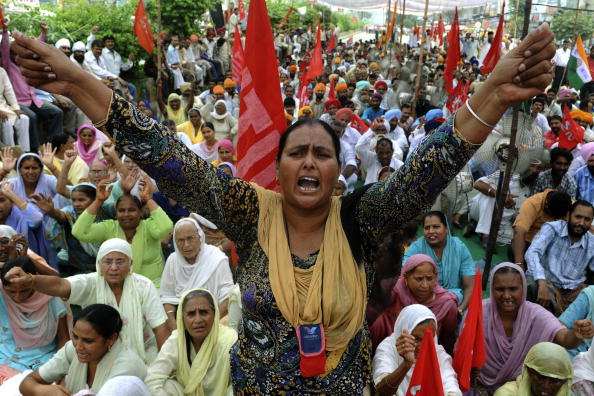For Organized Labor, India Points the Way Forward

AFP/Getty Images
Communist Party of India (Marxist) (CPI-M) supporters along with trade unionists shout slogans and wave flags during a protest rally in Amritsar on September 7, 2010, part of a nationwide strike. A strike called by trade unions and left parties in India to protest against rising prices and alleged anti-labour policies crippled life in the country. AFP PHOTO/NARINDER NANU (Photo credit should read NARINDER NANU/AFP/Getty Images)
September 29, 2016

On Sept. 2, between 150 and 180 million Indian workers walked out of their jobs carrying red banners and calling for, among other things, a higher minimum wage and increased rights in the workplace. The strike, which according to The Guardian is the largest of its kind in human history, emerged in reaction to the right-wing economic agenda of Indian Prime Minister Narendra Modi. His administration has been characterized by privatizations, eroded labor protections, and regressive tax hikes. Though the entirety of the U.S. mainstream media has been completely silent about this monumental walk-out, the radicalism and perseverance of the Indian working class is a lesson to a beleaguered American labor movement of what is possible when workers are ambitious and well-organized. If American workers wish to see a resurgent labor movement, it is clear they must learn from India.
It has been a difficult couple of decades for organized labor everywhere in the world, and India is no exception. Since the introduction of the right-wing “New Economic Policy” in 1991, the number of Indian workers covered by the protections of labor law has fallen to four percent of its overall workforce. This anti-labor push, along with privatizations and cuts to spending on social services, have been fueled by the global implementation of neoliberalism. This “neoliberalism” has been the manner in which capitalism has been administered worldwide since the 1980s and is characterized by an emphasis on unfettered markets, looser regulations on the power of foreign corporations, and a pervasive ideology of rugged individualism. Since the reigns of Thatcher and Reagan, the post-war social democracies that promised (at the very least) a “social floor” under which an individual’s standard of living could never fall, have fallen far out of favor.
But India’s trend of labor militancy could turn that tide. According to The Guardian, the Indian government has “pulled back from full privatization and left labour [sic] reform largely to the states” due to the power of radical and obstinate unions. The efforts of groups such as the All-India Trade Union Congress, the organized labor arm of the Communist Party of India (Marxist), have led to impoverished workers having a real voice in their workplaces and communities. Professor Mihir Sharma of the Delhi-based Observer Research Foundation says this general strike is a reflection of the power of the Indian labor movement to “remind the government of the cost of moving forward with its liberalisation programme [sic].”
The American labor movement once enjoyed this level of power and influence. In the 1930s, communists, socialists and trade unionists were able to pull the Democratic administration of Franklin Roosevelt enough to the left that the minimum program of a nascent welfare state was implemented under the name of the “New Deal.” The labor movement made real gains for American workers through political deals, agitation and most important of all, strikes. Included in the rich history of American labor is the radical International Workers of the World (IWW), which proudly called for the end of capitalism and wage labor, and the beginning of a new decentralized socialism known as “industrial democracy.”
Today, the situation is dire. According to the U.S. Bureau of Labor Statistics, only 13 percent of the American workforce is unionized, and pending “right-to-work” laws in numerous states could bring that number even lower. The unions that remain today often focus on small, short-term demands, such as marginal pay increases and slightly better benefits. The result of this strategy has been a labor movement unable to confront the excesses of neoliberal capitalism, and incapable of defending the American working class. Unions such as the International Brotherhood of Teamsters have been complicit in this degradation, focusing less and less in recent years on organizing and union democracy and more on acting as a mediator between management and workers. Because of this, conservative union leaders such as Teamsters President James P. Hoffa are currently facing challenges to their leadership from more radical opposition. The future of the American labor movement rests on the success of groups like Teamsters for a Democratic Union in their efforts to broaden the goals of their union and increase the democratic power of individual members.
For their own survival, workers in America must follow the example of their Indian comrades and think bigger. Unions in America must not only grow and democratize, but organized labor must return to the radical goals of the IWW and the 1930s Congress of Industrial Organizations. When labor dares to envision a new world, and recognize the forces that stand against it, there is nothing that it cannot achieve. The day American workers learn the lessons of the Indian general strike is the day they begin to assert the power of labor over capital, and of simple humanity over the forces of greed.









